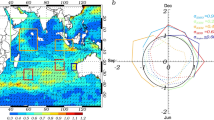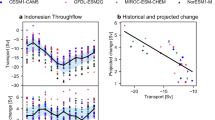Abstract
Climate variability in the Indian Ocean region seems to be, in some aspects, independent of forcing by external phenomena such as the El Niño/Southern Oscillation1,2,3,4. But the extent to which, and how, internal coupled ocean–atmosphere dynamics determine the state of the Indian Ocean system have not been resolved. Here we present a detailed analysis of the strong seasonal anomalies in sea surface temperatures, sea surface heights, precipitation and winds that occurred in the Indian Ocean region in 1997–98, and compare the results with the record of Indian Ocean climate variability over the past 40 years. We conclude that the 1997–98 anomalies—in spite of the coincidence with the strong El Niño/Southern Oscillation event—may primarily be an expression of internal dynamics, rather than a direct response to external influences. We propose a mechanism of ocean–atmosphere interaction governing the 1997–98 event that may represent a characteristic internal mode of the Indian Ocean climate system. In the Pacific Ocean, the identification of such a mode has led to successful predictions of El Niño5; if the proposed Indian Ocean internal mode proves to be robust, there may be a similar potential for predictability of climate in the Indian Ocean region.
This is a preview of subscription content, access via your institution
Access options
Subscribe to this journal
Receive 51 print issues and online access
$199.00 per year
only $3.90 per issue
Buy this article
- Purchase on Springer Link
- Instant access to full article PDF
Prices may be subject to local taxes which are calculated during checkout




Similar content being viewed by others
References
Nicholls,N. Air-sea interaction and the quasi-biennial oscillation. Mon. Weath. Rev. 106, 1505–1508 (1983).
Nicholls,N. All-India summer monsoon rainfall and sea surface temperature around northern Australia and Indonesia. J. Clim. 8, 1463–1467 (1995).
Meehl,G. A. Coupled ocean-atmosphere-land processes and south Asian monsoon variability. Science 265, 263–267 (1994).
Meehl,G. A. The south Asian monsoon and the tropospheric biennial oscillation. J. Clim. 10, 1921–1943 (1997).
Webster,P. J. & Palmer,T. N. The past and future of El Niño. Nature 390, 562–564 (1997).
Reynolds,R. & Marisco,D. An improved real-time global sea surface temperature analysis. J. Clim. 6, 114–119 (1993).
Kalnay,E. et al. The NCEP/NCAR 40-year reanalysis project. Bull. Am. Meteorol. Soc. 77, 437–471 (1996).
Hendricks,J. R., Leben,R. R., Born,G. H. & Koblinsky,C. J. Empirical orthogonal function analysis of global TOPEX/POSEIDON altimeter data and implications for detection of global sea level rise. J. Geophys. Res. 101, 14131–14145 (1996).
Yu,L. & Rienecker, M. M. Mechanisms for the Indian Ocean warming during the 1997–1998 El Niño. Geophys. Res. Lett. 26, 735–738 (1999).
Barnett,T. P. Interaction of the monsoon and Pacific Ocean trade wind systems at interannual time scales. Part I: the equatorial zone. Mon. Weath. Rev. 111, 756–773 (1983).
Arkin,P. & Meisner,B. The relationship between large-scale convective rainfall and cloud cover over the western hemisphere during 1982–1984. Mon. Weath. Rev. 115, 51–74 (1987).
Webster,P. J. Response of the tropical atmosphere to local steady forcing. Mon. Weath. Rev. 100, 518–541 (1972).
Gill,A. E. Some simple solutions for heat-induced tropical circulation. Q. J. R. Meteorol. Soc. 106, 447–462 (1981).
Near Real-Time Analysis of the Ocean and Atmosphere Fig T 29, p. 36 (Climate Diagnostics Bull. NO. 97/11, Climate Diagnostics Center, National Center of Environmental Prediction, NOAA, Washington DC, 1997).
Gill,A. Atmosphere-Ocean Dynamics (Academic, London, 1982).
Webster,P. J. et al. Monsoons: processes, predictability and the prospects for prediction. J. Geophys. Res. 103, 14451–14510 (1998).
Nicholson,S. E. & Kim,J. The relationship of the El-Niño Southern Oscillation to African rainfall. Int. J. Climatol. 17, 117–135 (1997).
Nicholson,S. E. An analysis of the ENSO signal in the tropical Atlantic and western Indian Oceans. Int. J. Climatol. 17, 345–375 (1997).
Reverdin,G., Cadet,D. & Gutzler,D. Interannual displacements of convection and surface circulation over the equatorial Indian Ocean. Q. J. R. Meteorol. Soc. 122, 43–67 (1986).
Kapala,A., Born,K. & Flohn,H. in Proc. Int. Conf. on Monsoon Variability and Prediction (ed. Newson, R.) 119–126 (Tech. Doc. 619, World Meteorological Organization, Geneva, Switzerland, 1994).
Rao,K. G. & Goswami,B. N. Interannual variations of the sea-surface temperature over the Arabian Sea and the Indian Monsoon: A new perspective. Mon. Weath. Rev. 116, 558–568 (1988).
Shukla,J. & Mooley,D. A. Empirical prediction of the summer monsoon over India. Mon. Weath. Rev. 115, 695–703 (1987).
Acknowledgements
This work was supported by the Office of Global Programs, NOAA, and the NSF (P.J.W., A.M.M., J.P.L.), and by NASA (R.R.L.).
Author information
Authors and Affiliations
Corresponding author
Rights and permissions
About this article
Cite this article
Webster, P., Moore, A., Loschnigg, J. et al. Coupled ocean–atmosphere dynamics in the Indian Ocean during 1997–98. Nature 401, 356–360 (1999). https://doi.org/10.1038/43848
Received:
Accepted:
Issue Date:
DOI: https://doi.org/10.1038/43848
This article is cited by
-
A negative biological Indian Ocean dipole event in 2022
Scientific Reports (2024)
-
Sea surface temperature anomaly of Southwest Pacific dipole in boreal Winter–Spring: a mechanism for the Indian Ocean Dipole
Climate Dynamics (2024)
-
Understanding the Association of Tropical SST Anomalies on the ISMR During Extreme IOD Events
Pure and Applied Geophysics (2024)
-
Attributing interdecadal variations of southern tropical Indian Ocean dipole mode to rhythms of Bjerknes feedback intensity
Climate Dynamics (2024)
-
Remote Sensing Observations of Ocean Surface Features and Productivity in the Southeast Arabian Sea Around Lakshadweep
Thalassas: An International Journal of Marine Sciences (2024)
Comments
By submitting a comment you agree to abide by our Terms and Community Guidelines. If you find something abusive or that does not comply with our terms or guidelines please flag it as inappropriate.



